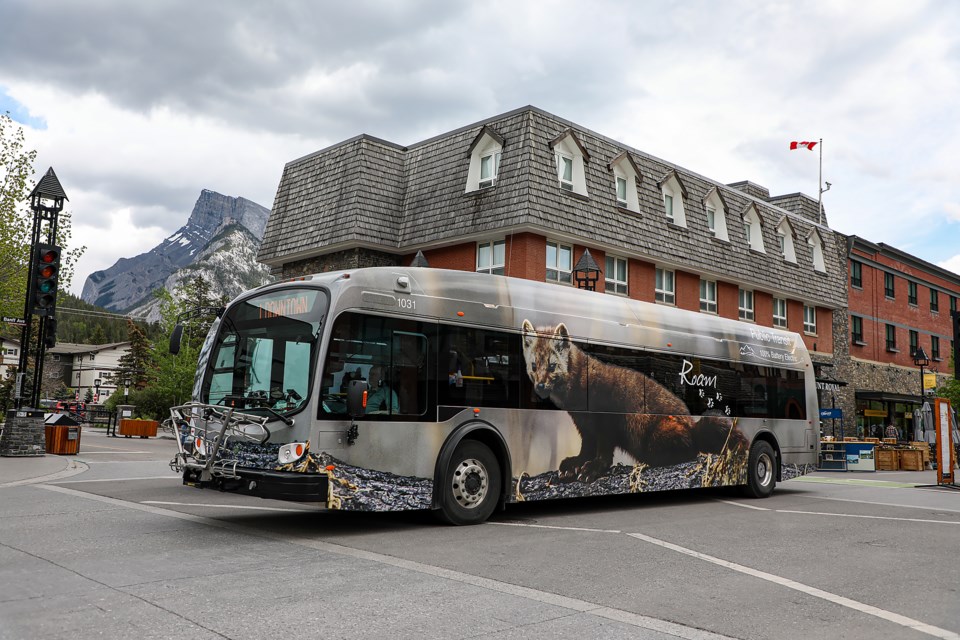Public transit in the Bow Valley has grown from once being a nice-to-have to being a need-to-have.
In the last decade – but particularly the past few years – the member municipalities and agencies for Roam transit have continued to emphasize the need to offer residents and visitors alternative options to personal vehicles.
Through policy guidance, councils’ direction and providing necessary resources for the transit service, people have not only been given the option but have turned to Roam as their main source of transportation.
As more people become reliant on it, ridership will only continue to increase.
Canmore offers free ridership on all its routes for visitors and residents, while Banff has free ridership for its residents. Several Banff hotels also provide free transit passes for guests, giving them the option of not needing their vehicles once they arrive in the mountain town. Both the MD of Bighorn and Kananaskis Improvement District have joined together for a transit feasibility study, only enhancing the possibility of Roam expanding its reach.
As of Aug. 22, Roam broke its ridership record by having 1.67 million riders – with more than four months remaining in 2023 – and the previous record being 1.65 million passengers in 2022.
While many of its public transit agencies across Canada have continued to struggle to rebound following the aftermath of the COVID-19 pandemic, Roam has only surged in its necessity to get people across the valley.
And while it offers people affordable transit options, the secondary impact is giving people the choice of needing a vehicle. After living costs and food, vehicle costs often round out the top three for expenses.
A 2019 Statistics Canada survey on household spending had shelter at 29.3 per cent of expenses followed by transportation at 18.5 per cent and food at 14.9 per cent. The survey had private transportation averaging $11,258 per household, but public transportation accounted for only $1,479.
When you give a person the option of not requiring a personal vehicle, you’re taking away expenses of fuel, maintenance, insurance, vehicle depreciation and parking. It can ultimately lead to thousands not being spent by an individual or family each year.
With the reality of families having two or more vehicles falling to the wayside each passing day, the necessity of giving other options is vital.
As simple as it may seem to build out the existing road system, the reality is it’s just not possible or feasibly smart for an area that’s constrained by national and provincial parks, mountains, and rivers in addition to millions of visitors and impacts on wildlife and the fact that when you have space it’s better used on housing than roads.
The draft 2024-26 operating and 2024-33 capital budget for Roam only highlights its importance in the Bow Valley.
In 2016, its budget was $1.958 million for 19,891 service hours with 12 drivers and three office staff. The upcoming budget for consideration is for $11.392 million, but allows for 75,423 service hours, 30 buses – a third of which are electric – and 110 part- and full-time staff.
Even at the popular destination of Moraine Lake, 106 commercial transit options have been approved by Parks Canada. No longer are thousands of cars being turned away at the Moraine Lake Road entrance that in past years looked more like a demilitarized zone than a gateway to the tourist hot spot.
Though those transit providers to Moraine Lake have differing frequencies, anyone who has tried to book a ride to Moraine Lake knows it can still take weeks to book a trip to the popular area showing people are ultimately less concerned about how to get there as long as they get to where they want to be.
Busing and its importance in the Bow Valley has become a way of life.
Any public budget and organization should be questioned and held accountable – it’s a necessity for a successful democracy to function – but Roam has shown its worth its weight in gold when it comes to addressing the present and future needs of transit in the Bow Valley.




